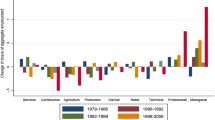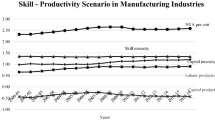Abstract
Occupations and sectors are the two fundamental dimensions of structural change. From the evolution of the high/low-skill employment levels and wage premium, we can study which sectors have been undertaking a process of technical change. We use Eu-Silc database to investigate the technological patterns followed before and after the 2008 crisis by four “Southern Europe” countries (Italy, Spain, Greece, Portugal) and three “Eastern Europe” countries (Poland, Hungary, Bulgaria) in comparison with the UK. Our empirical analysis shows that these two groups of countries follow heterogeneous patterns. Eastern Countries are not suffering from de-industrialization and are more oriented toward SBTC, as they are likely to perform better than Southern Countries. In particular, Poland stands out among the Eastern countries and Portugal among the Southern Countries, because they are closest to the UK in terms of technology ratio (level and dynamics after the crisis) and in terms of SBTC tendency.








Similar content being viewed by others
Notes
“A noteworthy implication of this framework is that technical change favoring one type of worker can reduce the real wages of another group. Therefore, the richer substitution possibilities between skill groups afforded by the endogenous allocation of skills to tasks highlights that, distinct from canonical model, technical change need not raise the wages of all workers. As importantly, this framework enables us to model the introduction of new technologies that directly substitute for tasks previously performed by workers of various skill levels. In particular, we can readily model how new machinery (for example, software that corrects spelling and identifies grammatical errors) can directly substitute for job tasks performed by various skill groups. This type of technical change provides a richer perspective for interpreting the impact of new technologies on labor market outcomes” (Acemoglu and Autor, 2011, pp.79-80).
The opposite result (σ < 1) was found in an estimate dealing with the United States (Lawrence 2015).
The Cambridge critique to the neoclassical production function maintains that the value of the capital stock is not independent from prices and distribution.
In Eu-Silc we use the variables pl050 (ISCO-88, 2-digit) and pl051 (ISCO-08, 2-digit). The change from ISCO-88 to ISCO-08 occurred in 2009. The differences between ISCO-88 and ISCO-08 in principle could affect the results, but empirically it is quite unlikely as we actually use the 1-digit classification and, hence, the differences between the two codifications are minimal. http://www.ilo.org/public/english/bureau/stat/isco/isco08/index.htm
The variable in Eu-Silc is py200g. This variable has many missing values (eg, it is not available for Germany), but it is the only variable about “earnings” or “income” that is time coherent with the variable about ISCO classification. In the dataset, the main variable about income refers to the previous year, while ISCO classification refers to the current year.
Summing up, we keep only the cases with valide responses about wages (Eu-Silc: py200g), ISCO classification (pl050/pl051), sector of activity (pl110/pl111), and employment (pl040). When data processing deserve weights, we use the personal cross-sectional weight provided by Eu-Silc (pb040).
Michaels et al. (2014), for example, focus on the role of computerization and contend that SBTC models do not adequately account for rising wage inequality over the last three decades. It is worth highlighting that here we are using the SBTC strategy as a shortcut for a context with growing HR and SP.
It might be worth recalling that, although wages usually represent the lion’s share of personal income, wage inequality more strictly relates to the labor market rules, while income inequality usually looks at disposable equivalent income and refers to the whole population.
References
Acemoglu D (2002) Technical change, inequality, and the labor market. J Econ Lit 40(1):7–72 . https://doi.org/10.1257/0022051026976. http://www.aeaweb.org/articles?id=10.1257/0022051026976
Acemoglu D (2003) Cross-country inequality trends. Econ J 113(485):F121–F149. https://doi.org/10.1111/1468-0297.00100
Acemoglu D, Autor D (2011) Skills, tasks and technologies: implications for employment and earnings, handbook of labor economics, chap 12, vol 4. Elsevier, Berlin, pp 1043–1171. https://ideas.repec.org/h/eee/labchp/5-12.html
Acemoglu D, Restrepo P (2017). Robots and jobs: Evidence from us labor markets. Working Paper 23285, National Bureau of Economic Research, https://doi.org/10.3386/w23285. http://www.nber.org/papers/w23285
Aghion P, Akcigit U, Bergeaud A, Blundell R, Hémous D (2015). Innovation and Top Income Inequality. NBER Working Papers 21247, National Bureau of Economic Research, Inc. https://ideas.repec.org/p/nbr/nberwo/21247.html
Arrow KJ, Chenery HB, Minhas BS, Solow RM (1961) Capital-labor substitution and economic efficiency. Rev Econ Stat 43(3):225–250. http://www.jstor.org/stable/1927286
Autor D, Dorn D, Katz LF, Patterson C, Van Reenen J (2017) Concentrating on the fall of the labor share. Am Econ Rev 107(5):180–85. https://doi.org/10.1257/aer.p20171102. http://www.aeaweb.org/articles?id=10.1257/aer.p20171102
Autor D H, Levy F, Murnane R J (2003) The skill content of recent technological change: an empirical exploration*. Q J Econ 118(4):1279–1333. https://doi.org/10.1162/003355303322552801
Bassanini A, Manfredi T (2012). Capital’s grabbing hand? a cross-country/cross-industry analysis of the decline of the labour share. OECD Social, Employment and Migration Working Papers (133), https://doi.org/10.1787/5k95zqsf4bxt-en. https://www.oecd-ilibrary.org/content/paper/5k95zqsf4bxt-en
Berndt ER (1976) Reconciling alternative estimates of the elasticity of substitution. Rev Econ Stat 58(1):59–68. http://www.jstor.org/stable/1936009
Brada J C, Signorelli M (2012) Comparing labor market performance: Some stylized facts and key findings. Comp Econ Stud 54(2):231–250. https://doi.org/10.1057/ces.2012.20
Brugger F, Gehrke C (2017) The neoclassical approach to induced technical change: From hicks to acemoglu. Metroeconomica 68(4):730–776. https://doi.org/10.1111/meca.12141https://onlinelibrary.wiley.com/doi/abs/10.1111/meca.12141
Croci-Angelini E, Farina F (2008) Technological choices under institutional constraints: measuring the impact on earnings dispersion. In: Betti G, Lemmi A (eds) Advances in income inequality and concentration measures. Routledge
David PA, van de Klundert T (1965) Biased efficiency growth and capital-labor substitution in the u.s., 1899-1960. Am Econ Rev 55(3):357–394. http://www.jstor.org/stable/1814555
Delli Gatti D, Gallegati M, Greenwald BC, Russo A, Stiglitz JE (2012) Mobility constraints, productivity trends, and extended crises. J Econ Behav Organ 83 (3):375–393. https://doi.org/10.1016/j.jebo.2012.03.011. http://www.sciencedirect.com/science/article/pii/S0167268112000649, the Great Recession: motivation for re-thinking paradigms in macroeconomic modeling
Dosi G (1997) Opportunities, incentives and the collective patterns of technological change. Econ J 107(444):1530–1547. https://doi.org/10.1111/j.1468-0297.1997.tb00064.x. https://onlinelibrary.wiley.com/doi/abs/10.1111/j.1468-0297.1997.tb00064.x
Dosi G, Fagiolo G, Napoletano M, Roventini A (2012) Economic policies with endogenous innovation and keynesian demand management. In: What’s right with macroeconomics?. Edward Elgar Publishing, pp 110–148
Dosi G, Fagiolo G, Napoletano M, Roventini A (2013) Income distribution, credit and fiscal policies in an agent-based keynesian model. J Econ Dyn Control 37(8):1598–1625. https://doi.org/10.1016/j.jedc.2012.11.008. http://www.sciencedirect.com/science/article/pii/S0165188913000213
Griliches Z (1969) Capital-skill complementarity. Rev Econ Stat 51 (4):465–468. https://doi.org/10.2307/1926439. https://www.jstor.org/stable/1926439
Griliches Z (2001) R&d, education and productivity : a retrospective. Harvard University Press, Cambridge; London
Guscina A (2006). Effects of Globalization on Labor’s Share in National Income. IMF working paper ; WP/06/294, International Monetary Fund. https://books.google.it/books?id=Dj-4K2C7fMQC
Hamermesh D (1993) Labor Demand. Princeton paperbacks. Princeton University Press, Princeton. https://books.google.it/books?id=XkLDQgAACAAJ
Hicks J (1932) The theory of wages. Palgrave Macmillan, London. https://doi.org/10.1007/978-1-349-00189-7
Hornstein A, Krusell P, Violante GL (2005) The effects of technical change on labor market inequalities. In: Aghion P, Durlauf SN (eds) Handbook of Economic Growth. https://doi.org/10.1016/S1574-0684(05)01020-8. http://www.sciencedirect.com/science/article/pii/S1574068405010208, vol 1. Elsevier, pp 1275–1370
Karabarbounis L, Neiman B (2014) The global decline of the labor share. Q J Econ 129 (1):61–103. https://doi.org/10.1093/qje/qjt032, /oup/backfile/content_public/journal/qje/129/1/10.1093/qje/ qjt032/2/qjt032.pdf
Lawrence RZ (2015). Recent Declines in Labor’s Share in US Income: A Preliminary Neoclassical Account. NBER Working Papers 21296, National Bureau of Economic Research, Inc. https://ideas.repec.org/p/nbr/nberwo/21296.html
Michaels G, Natraj A, Van Reenen J (2014). Has ICT polarized skill demand? Evidence from eleven countries over 25 years. LSE Research Online Documents on Economics 46830, London School of Economics and Political Science, LSE Library. https://ideas.repec.org/p/ehl/lserod/46830.html
OECD (2015). Oecd science, technology and industry scoreboard 2015 https://doi.org/10.1787/sti_scoreboard-2015-en. /content/book/sti_scoreboard-2015-en
OECD (2017). Future of work and skills. Paper presented at the 2nd Meeting of the G20 Employment Working Group
Valentini E, Arlotti M, Compagnucci F, Gentili A, Muratore F, Gallegati M (2017) Technical change, sectoral dislocation and barriers to labor mobility: Factors behind the great recession. J Econ Dyn Control 81:187–215. https://doi.org/10.1016/j.jedc.2017.05.005. http://www.sciencedirect.com/science/article/pii/S0165188917301021
Vona F, Consoli D (2015) Innovation and skill dynamics: a life-cycle approach. Ind Corp Change 24(6):1393–1415. https://doi.org/10.1093/icc/dtu028. /oup/backfile/content_public/journal/icc/24/6/ 10.1093_icc_dtu028/2/dtu028.pdf
Zambelli S (2018) The aggregate production function is not neoclassical. Camb J Econ 42(2):383–426. https://doi.org/10.1093/cje/bex011
Zambelli S, Fredholm T, Venkatachalam R (2017) Robust measurement of national technological progress. Struct Change Econ Dyn 42:38–55. https://doi.org/10.1016/j.strueco.2017.05.001. http://www.sciencedirect.com/science/article/pii/S0954349X17301467
Author information
Authors and Affiliations
Corresponding author
Ethics declarations
Conflict of interest
The authors declare that they have no conflict of interest.
Additional information
Publisher’s note
Springer Nature remains neutral with regard to jurisdictional claims in published maps and institutional affiliations.
Rights and permissions
About this article
Cite this article
Angelini, E.C., Farina, F. & Valentini, E. Wage and employment by skill levels in technological evolution of South and East Europe. J Evol Econ 30, 1497–1514 (2020). https://doi.org/10.1007/s00191-020-00682-8
Published:
Issue Date:
DOI: https://doi.org/10.1007/s00191-020-00682-8




